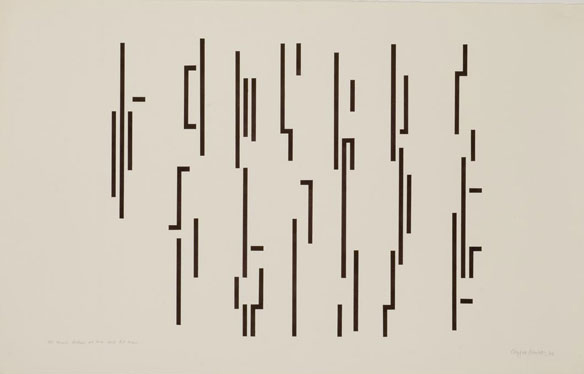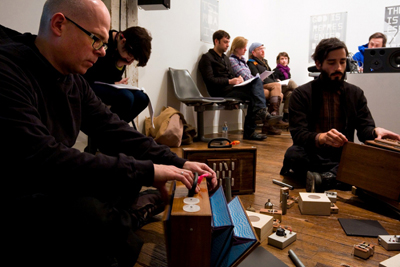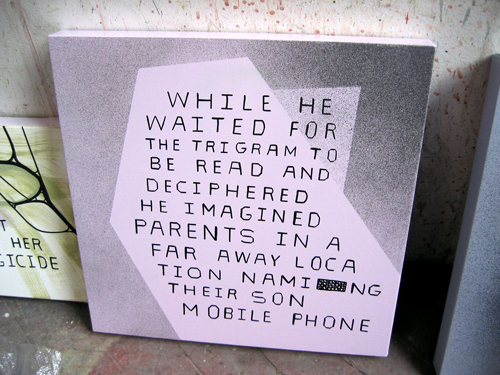Witness Mark Booth
A prosodic variable is the type of constant

Susan Howe’s recuperation of Emily Dickinson’s visual prosody marks a pivot point in American poetics, insofar as it calls attention to the long effaced but paradigmatically American enterprise of self-invention that Dickinson’s practice depicts. And in depicting her work, the picture is the work, hence the holograph images that for the most part replace block quotes in texts like Howe’s My Emily Dickinson and the essay from which I’ll cull this epigraph, “These Flames and Generosities of the Heart.”
This space is the poem’s space. Letters are sounds we see. Sounds leap to the eye. Word lists, crosses, blanks, and ruptured stanzas are points of contact and displacement. Line breaks and visual contrapuntal stresses represent an athematic compositional intention.
Howe, and by extension Dickinson, are reference points for discussing the work of Mark Booth, printmaker by training, a painter, who also works in sound and performance, but whose practice is in some sense reducible to writing. I consider him a poet. And in my opinion, his work is one of the most engaging of many going concerns in Chicago’s art and literary scenes. If nothing else, I want to use this last commentary to introduce you to Booth’s work, acclaim it, and also try to come to grips with it myself, a little. His projects are fundametnally iterative, so they manifest in multiple ways. This multiplicity tempts me to stop at enthusiasm and forego analysis, at least in relation to the work I’ve seen, heard, and (full disclosure) participated in. So I had to inject some sense of duty in relation to it. When I undertook the project of writing these commentaries for Jacket2, I set only three parameters. First, I drafted the statement in the sidebar to the right, delimiting my topic. Second, I named names to delimit my subjects. Third, I commissioned a banner image from Booth. Now, at the end of the series, I return to the initial impulse behind it. In short, I will think through this material as a becoming rather than a conclusion.
Some reference points for Booth’s work are as follows. In sound, Robert Ashley, a professed influence. Booth completed a sound piece for the 2007 Chicago book release event for Hannah Weiner’s Open House, layering tracks reciting passages from Weiner’s “Silent History.” His sole voice enunciates the poem’s frenetic, hermetic lexical units with a crystalline sobriety. This is punctuated by a choral chant of “silence,” “silences,” “history,” “power”—these voices clearly do not belong to him. The cues are not obviously patterned, but they give the feeling of an underlying system and an algorithmic proliferation or continuous variation that is in the first voice’s material (the words) but under erasure in the chorus (reduced to four key terms). The last phrase of the poem is “without mental excitement” (the lexical units rarely add up to phrasal units, so a lot of pressure can be put on the moments when they do). That same year, I read “Silent History” at release events in Vancouver, Portland, Ashland, San Francisco, Santa Cruz, and Los Angeles. I first heard Booth’s piece literally the day before leaving home for the West Coast reading tour. But instead of trying to emulate the careful balance struck between Booth and his chorus, I read the piece in a frenzy, trying to take it all in one breath—displacing any “mental excitement” to the voice. I should have just played Booth’s recording, though. I think it’s only been heard once. Obviously, Ashley’s command of a “whole art”—opera—provides a reference point for Booth’s meticulous array of coordinates: medial, thematic, and intentional. Ashley’s Celestial Excursions, though, actually sounds like Booth’s “Silent History.” The cyclical pulse of chorus and solo voice, especially.
In drawing, print, painting, Christopher Knowles’ Typings and Guy de Cointet’s ink and pencil drawings. De Cointet’s wit and whimsy are redolent in Booth’s writing. But visually, also, drawings like His Music Looked at Me and Bit Me share a visual idiom. Nothing is withheld, but the signifier is only found between space and grapheme, where one must look for it. It is drawn language, the way the eye of the beholder is drawn through it.

Guy de Cointet, His Music Looked at Me and Bit Me (1976)
In writing, Mark E. Smith’s phonic orthography and love of obscure, even private acronyms come to mind. In a gallery talk at the MCA Chicago’s 12x12 series, Booth mentioned listening to The Fall’s Perverted by Language while working on the paintings hanging behind him, and I thought yes, of course! Smith was my initiation into the fact that orthography was not a dictate but a generative constraint. Smith will write “frenz” instead of “friends,” “N.W.A.” instead of “the north will rise again,” etc. This isn’t a tick or a gimmick, a style as set of symptoms or signature traits. It actually runs ripples through commonalities and construals, pronunciation and presentation, that ameliorate discordances in a language by rendering them equally susceptible to a single force. From a given angle, this force is either audible, visible, or legible. One can’t just listen to a Fall album, look at a Booth painting, read the writing of either.
Which brings me to the issue that most baffles me. How does Booth write? Visiting his studio last spring, he showed me a stack of ink drawings he’d just worked up that month, half angular, abstract drawing and half prose poetry—the two halves split down the middle, as though it were self transcribing. But which is the apparition, image or statement? As he described them to me, I realized he writes in situ, drawing all the while. Poiesis precisely.
This space is the poem’s space. Letters are sounds we see. Sounds leap to the eye. Word lists, crosses, blanks, and ruptured stanzas are points of contact and displacement. Line breaks and visual contrapuntal stresses represent an athematic compositional intention.
When I asked him to provide the banner for these “Witness” commentaries, I stupidly assumed he might cull an image from an existing work, reframe it, and to that end I told him that I particularly admired this piece.

Mark Booth, Mathmathmatics Prayer Group, from the exhibition ENDLESS (PERVERTED BY LANGUAGE/DELAY 1968)
Wit and whimsy, but I was also attracted to the use of color. Well, he worked for what seemed like weeks on a variation, in another mode, and another medium: photography. With the first batch of images he sent this question: “Do you want to shorten the line to ‘mathematics prayer group’ thereby correcting dyslexic stutter and spelling errors? The latter makes sense to me as I'm doing something new with an old line that can be corrected in the new process of articulation.” I responded this way. “I have never considered the role of correction or revision outside of visible strike-thru or overlay, layering, smudge, swipe, the sense of keeping a process going. Or the mirroring of drawing and writing (those pieces I saw this spring in your studio). I also think that the rhetorical value of the misspelling of mathematics is particularly effective. But if you're now interested in the revision, that would seem to mean it is a part of this new piece. That the correction belongs to it.” Obviously, in the end the atypical expression was retained, but it still seemed peculiar that revision was entertained in the first place, much less that it was an option offered to me. Doing something new, as he put it, is a matter of “articulation,” a word etymologically traceable to cutting, splicing, and here literally that. He had hand cut the letters and set them in garden/leisure environments. One imagines them blowing apart in a breeze (“sky”), and the fibrile letter forms in what look like mylar are adjoined, as cutouts, to fluctuation—articulatory flux. The original phrase insists, in the Steinian sense of not repeating but inflecting, in both letter and spirit. Hence the “prayer,” the “group,” and the stammering. And the stammer just looks right, somehow.

Booth (in the foreground) and collaborators performing God Is Represented by the Sea at Devening Projects
This resonates with “Silent History,” but even moreso with God Is Represented by the Sea, a project that has had many iterations, including a durational performance I attended one extremely forebidding winter day in 2011, at Devening Projects. The piece consisted of four hours spent in a small gallery with the prints hung around us, the electronics and bellows duo Coppice, joined by Booth, playing on the floor in the center of the room, and a table full of readers who read the text, cycling through it. (Readers included poets and novelists like Devin King, Caroline Picard, and Peter O’Leary.) Booth describes the score/text as an “anadiplotic list.” In the performance condition he set up there, anadiplosis registered as a sort of renga-like chain, inherently collaborative, ritualistic, yet with a parlor game and/or garden party ambience. A phase-effect of gradual shading and shifting softens the desire for completion, becoming something like what Whitehead called a lure for feeling. While the first line, “God is represented by the sea” will lead to another representation until, ultimately, all of the lines converge on their source (God), this convergence is nascent in the role of representation itself, which always depends on the One. I would argue that this role is not semiotic in the structuralist sense, nor contractual in a socio-political sense, but is rather a becoming or univocity of being, in the ontological sense. “God” might stand as well as, say, “carbonated water” stands for “space.”
Scroll through the images if you want to see for yourself, or listen in. There is just enough logic to every sentence to insinuate the next. There are no logical leaps, but one has the sense a great distance is traversed, ramifying the whole at every refrain. Perhaps the writing was spontaneous. And while the reading is successive, it amounts to a simulcast. An all-at-once, overwhelming one’s attention in a soothing way (destined for nothing in particular, you start to float a little). You can leave off and resume at any instant whatsoever. This is the pace of thought without thoughts. I think the piece is finally about refusing to ignore the limits of cognition. Sublimity, yes, but a euphoric, celestial calm that, even when it becomes crowded, respects and presents the immanent integrity of its elements (this is what de Cointet’s His Music Looked at Me and Bit Me does with the letterform, too). The dispersal of the line draws toward and maybe becomes an ecology. I would have written “ecosystem,” except that I want logos in the suffix for the important reason that God Is Represented by the Sea is a becoming in writing.

A shot of Booth's studio, works exhibited in the 12 x 12 Gallery of the MCA Chicago
Many of you will notice I have been, without much subtlety, siphoning Deleuze-Guattarian paradigms throughout my descriptions of Booth’s work. I don’t know that he’d profess any interest, much less any influence, care of that theoretical corpus. But their description of the linguistic “tensor” in A Thousand Plateaus, to my mind, unambiguously plays into practically every other attempt to describe his work that I have encountered. Michelle Hyun: “Booth’s project…begins with sound…continues in the mind’s ear…the closed, albeit infinite, loop of meaning and never-ending difference…presented as artistic sacrifice…[and cries] out for a new mode of analysis.” Matthew Goulish: “The question in this laboratory, where cloud becomes word becomes body, is less one of ethics (How should one live?) and more one of a deployment of imagination (How might one live? How might one enchant the world through observation?).” I wish to observe only that the mode of difference in itself here is of a type, an “atypical” expression channeled by grammatical sobriety. Which leads me to Deleuze and Guattari’s description of the tensor as a form of Boothian anadiplosis.
[T]he atypical expression…produces the placing-in-variation of the correct forms, uprooting them from their state as constants. The atypical expression constitutes a cutting edge of deterritorialization of language, it plays the role of tensor; in other words, it causes language to tend toward a near side or a beyond of language. The tensor effects a kind of transitivization of the phrase, causing the last term to react upon the preceding term, back through the entire chain. It assures an intensive and chromatic treatment of language. An expression as simple as AND…can play the role of tensor for all of language. In this sense, AND is less a conjunction than the atypical expression of all the possible conjunctions it places in continuous variation. The tensor, therefore, is not reducible either to a constant or a variable, but assures the variation of the variable by subtracing in each instance the value of the constant (n – 1).
Which, in turn, brings me back to Dickinson. At one point above, I describe the mirroring of line and letterform as a situation in which writing, for Booth, takes place. It is as though the drawing and writing are audience to one another, and so I come upon the whole piece as an interpretation underway, rather than an object of scrutiny, an ecology rather than an ecosystem. I’m thinking also of Steve Benson’s performative lecture "Leavings and Cleavings," wherein he describes a quatrain from Dickinson as “circular, or out of order.” The “or” is the tensor, because while the representational value of “God” is putatively circular—as Hyun put it, “closed, albeit infinite”—the globe or “ball” lends a third dimension to the “disk” or circle, the “loop of meaning,” that renders meaning irreducible. It is curious that Benson should emphasize this point in this way, being a master of transcription, or reverse-scoring “talk” (in a piece like Views of Communist China, for example). Becoming is a transversal rather than a reversal of elements; not a two part trope but a dispersive presentation or multiplicity that makes for a “poetic” experience, if there is something inherent to the prosodic cue glimpsed and therefore actionable, after all.
The Dust behind I strove to join
Unto the Disk before –
But Sequence ravelled out of Sound
Like Balls upon a Floor –
Witness